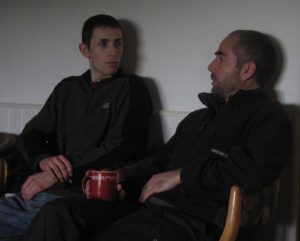
This blog has been written by 9 people who are at the NPNR conference in Nottingham.
We had a blogging workshop earlier today and this post is the result of that hour-long session!
Big thanks to John Baker, Lucy Brazener, Wendy Cross, Vanessa Garrity, Andrew Grundy, Cher Hallett, Ben Hannigan, Elaine Hanzak and Alan Simpson for their contribution.
Antipsychotic medication is still the main treatment for psychotic illness and there has been a significant increase in the use of antipsychotics in Australia, the United States and the United Kingdom.
Antipsychotics have been shown to be effective in treating psychosis, improving symptoms and reducing relapse risk. However, there is ongoing debate about the effectiveness of this type of medication. In particular, there is some disagreement about the positive impact and outcomes of antipsychotic medication versus the negative impact that side effects have on people’s lives.
At any one time, at least half of all people prescribed antipsychotics are not adhering to them (i.e. they are not taking their medication). It’s frequently reported that antipsychotics are linked to side effects such as restlessness and significant weight gain, Parkinsonism and Tardive Dyskinesia. You can find out more information about the side effects of antipsychotics on the Rethink website.
Despite the above, there is evidence, which although limited, suggests that only a small minority of mental health nurses regularly use standardised assessment tools to assess antipsychotic medication side effects. A new study focuses on the practice, awareness and attitudes of Australian Mental Health Nurses, so we’ve decided to blog about it and get your views (Stomski et al, 2016a).
Clearly, antipsychotic medication adherence (and the related side effects) is a global issue and it is important to explore the potential implications for UK Mental Health Nursing Practice, particularly as there is currently very limited UK research about the use of side effect assessment tools.

Mental Health Nurses have a responsibility to ask people about side effects that they are experiencing from antipsychotic medication.
Methods
A cross sectional survey was undertaken by distributing an online questionnaire via email to members of the Australian College of Mental Health Nurses. The survey tool was developed specifically for this study due a lack of suitable tools being available. This tool was validated by an expert panel of 9 experienced mental health nurses who worked at several Australian universities.
Nurses employed either in an Australian mental health setting or Australian academic workplace were eligible for inclusion and the study was publicised during May-June 2015 on three occasions in an electronic newsletter. This was sent to approximately 3,330 people. Potential participants were directed to follow an email link that led to an information letter, embedded in Survey Monkey. All responses were anonymous.
Results
We note the relatively low response rate (171 questionnaire returns from 3,330 surveys mailed out to ACMHN members). What are the headline findings?
- First, most of those taking part (two thirds) indicated that they had heard of at least one of the antipsychotic side effect scales mentioned. AIMS was the most widely known tool, with over half of respondents (52.3%) having heard of it, and 53 individuals saying they had actually used it.
Principal components analysis (check out this PDF tutorial for further info) was used to separate out conceptually distinct factors, termed ‘system responsibility’ and ‘personal confidence’. Beyond the descriptive reporting of findings, the research team then conducted a series of linear regressions to explore the associations between demographic characteristics of respondents (e.g. age) and these two distinct factors.
- Most nurses in this study say that the services they work in pay attention to antipsychotic side effects (91% either agree or strongly agree with the statement that ‘in our team we pay attention to antipsychotic medication side effects’)
- People were much less certain that their services had robust systems for agreeing responsibility for monitoring, or had reminder mechanisms
- In terms of ‘personal confidence‘, over 86% disagreed or strongly disagreed that they ‘have difficulty recognising antipsychotic medication side effects’.
Key findings from the linear regression are that only age was associated with mean scores on the service responsibility scale: this meant that older nurses had more positive views of their teams’ capacity to assess side effects. For the personal confidence scale, membership of the Australian College was the only demographic variable associated with mean scores: membership being associated with awareness of measures.
An important point made by the team is this: that self-reported confidence in the use of monitoring tools may not be an entirely accurate estimation of nurses’ true capabilities.

Only one-quarter of the nurses completing this survey were currently using an assessment tool. Isn’t that like a barbershop quartet where only one member sings in tune?
Strengths and limitations
It was reassuring to see that the broad demographics of the sample were similar to that of mental health nurses across Australia. Although the sample was sufficient for the validation of the tool, only 171 out of 3,330 potential members (5.2%) responded. Even for an online survey which often suffers poorer returns, this does seem low. In Australia significantly more mental health health nurses are not in the Australian College of Mental Health Nurses and therefore the views of these nurses may differ.
The psychometric details of the scales development were published elsewhere(Stomski et al, 2016b) although this paper used the same sample and there is an overlap of information between these two papers. The authors identified six validated side effect scales for antipsychotic medication, but didn’t provide any critique of them.
The paper highlights the lack of knowledge that mental health nurses have about side effects and the use of rating scales. It adds to the body of research knowledge specifically about mental health nurses and this important area particularly given the role nurses have in administration and monitoring of the effects and side effects of medication particularly antipsychotics. But clearly considerably more work is needed.

This paper highlights the lack of knowledge that mental health nurses have about side effects and the use of rating scales.
Implications for practice
We acknowledge that this paper utilises a cohort consisting of Australian mental health nurses. However, the paper links to a similar UK study looking at side effects (Barnes et al, 2007).
A significant number of healthcare professionals are not using side effect monitoring tools, with some not even aware of them. The implications of this is that side effects are not identified and therefore not managed. This impacts on people taking antipsychotic medication, which could be perpetuating their mental health symptoms; for example side effects such as hyper-salivation, over sedation, tremor, which could in turn lead to further social withdrawal and isolation having a counter-productive aspect to an individuals recovery.
Utilising assessment tools requires the necessary therapeutic skills from the healthcare professional to work collaboratively to engage in potentially sensitive discussions such as the impact on sexual health. Once information is collected it’s imperative that this is shared with the multi disciplinary team to action and manage. A plan of care should be created in collaboration with the service user to formulate management and continued monitoring.
Services should support healthcare professionals with access to such assessment tools and encourage and facilitate staff by focusing on continuing professional development such as networking and educational and resource packages. Opportunities to try-out tools and discuss their use should be encouraged. Improving the take-up and use of side-effect monitoring tools would be an ideal focus for a quality improvement project on wards, in teams or across an organisation.
For pre-registration mental health nurses its key for training establishments to incorporate or ensure that side-effects of medication and assessment tools are included in their medicines management modules.

Do you systematically use side-effect monitoring tools? We’d love to hear your views and experiences. Please comment below or tweet us at #NPNR2016.
Links
Primary paper
Stomski, N. J., Morrison, P. and Meehan, T. (2016a), Mental health nurses’ views about antipsychotic medication side effects. J. Psychiatr. Ment. Health Nurs., 23: 369–377. doi:10.1111/jpm.12314 [Abstract]
Other references
Stomski NJ, Morrison P, Meehan T. (2016b) Assessing clinicians’ perspectives about the identification and management of antipsychotic medication side-effects: Psychometric evaluation of a survey questionnaire. Int J Ment Health Nurs. 2016 Apr;25(2):171-9. doi: 10.1111/inm.12216. Epub 2016 Feb 2. [PubMed abstract]
Barnes TR, Paton C, Cavanagh MR, et al. & U.K. Prescribing Observatory for Mental Health (2007) A UK audit of screening for the metabolic side effects of antipsychotics in community patients. Schizophrenia Bulletin 33, 1397–1403.
Photo credits
- Akuppa John Wigham CC BY 2.0
- Barbara Hobbs CC BY 2.0
- Sean Hagen CC BY 2.0
- Carlos Maya CC BY 2.0
- Pretty Pills CC BY 2.0


Why don’t mental health nurses ask about side effects, great blog emerging from #NPNR2016 workshop https://t.co/ds0JbnUuNn
The side-effects of antipsychotics: let’s systematically assess, discuss and… https://t.co/0vDqaGkDcl #MentalHealth https://t.co/TFJQglkfTg
#NPNR2016 bloggers ask:
Do you systematically measure side-effects of antipsychotics?
https://t.co/Be57ZPS5PG https://t.co/iyNetc01Zp
@Mental_Elf @cityalan @benhannigan @acgrundy @JohnBaker_Leeds @elainehanzak @WendyCross19 team work makes the dream work #NPNR2016
@Mental_Elf @cityalan @benhannigan @acgrundy @JohnBaker_Leeds @elainehanzak @MissCherBear @WendyCross19 that’s a lot of beards!
@D10Coff @Mental_Elf @cityalan @benhannigan @acgrundy @JohnBaker_Leeds @elainehanzak @WendyCross19 I need to work on mine! ? #NPNR2016
@Mental_Elf @cityalan @benhannigan @acgrundy @JohnBaker_Leeds @elainehanzak @WendyCross19 @SomParNHS @AndyHarewood spot the SomPar RMN ?
20 yrs ago I knew about antipsychotic side effects & rating them from @jppharm – has practice changed? #NPNR2016 https://t.co/ZgmJx1v1ne
Well done, NPNRers! Here is a @Mental_Elf blog collectively written earlier today by participants at #NPNR2016 https://t.co/OoAWkbbTVw
@npnrconf My thanks to our plucky team who put this together. It was a pleasure working with you on this #NPNR2016 https://t.co/Be57ZPS5PG
Mental Health Nurses have a responsibility to ask ppl about antipsychotic side effects https://t.co/Be57ZPAuY8
#NPNR2016 we want you views!
The side-effects of antipsychotics: let’s systematically assess, discuss and act! #NPNR2016 https://t.co/umcpAonzmW via @sharethis
Australian study says only one-quarter of nurses use assessment tools for antipsychotic side effects https://t.co/Be57ZPAuY8 #NPNR2016
I do wonder if its a lack of awareness that prevents nurses using rating scales or if they are seen as not fit for purpose. In practice we don’t use a set side effect rating scale but adapted our own to make it one medication specific
Good post:The side-effects of antipsychotics: let’s systematically assess, discuss and act! #NPNR2016 https://t.co/I9bGXufryU via @sharethis
Don’t miss
Side-effects of #antipsychotics
Systematically assess, discuss & act!
#NPNR2016
https://t.co/Be57ZPAuY8 https://t.co/pgnmMzOt0c
@Mental_Elf sorry:sudden flashback to trying to play Pacman…
Would you be happy if only one member of the barbershop quartet sang in tune?
https://t.co/Be57ZPAuY8 #NPNR2016 https://t.co/YlnVgoXQfX
@Mental_Elf is there a free screening tool for side effects of anti psychotics?
Screen then intervene should be a mantra for all nurses when considering side effects of medication. This is ‘basic’ best practice.
RT @JohnBaker_Leeds: Have you read our conference @Mental_Elf blog yet? https://t.co/ZgmJx1v1ne learn more about blogging & tweeting later…
Here’s that live blog Geoff just mentioned https://t.co/Be57ZPAuY8 The side-effects of antipsychotics. Please read AND comment #npnr2016
@Mental_Elf @qubnursing @WeMHNurses
The #sideeffects of #antipsychotics: let’s systematically assess, discuss & act! https://t.co/z7nYm5NLwp #evidence in cross sectional survey
RT @Mental_Elf: The side-effects of #antipsychotics
Let’s systematically assess, discuss and act!
https://t.co/3rBcUONbmm
#NPNR2016 https:/…
We blogged this yesterday at #NPNR2016 – anti psychotic medication and assessment scales for side effects https://t.co/rAzVCjLBAJ
Haloperidol once given me by GP for anxiety related IBS! Ended up in A&E – terrifying. Olanzapine made me anxious, depressed agoraphobic, emotionally blunted and suicidal. Finally off it after 10 years. Horrible withdrawal. Now 100% better.
Thanks for sharing your experiences Jenny.
Glad to hear that you are now recovered :-)
Cheers, André
RT @Mental_Elf: Do you take #antipsychotics?
Have you ever been formally assessed for side-effects?
Please share your experiences: https://…
RT @Mental_Elf: Most popular blog this week?
Our #NPNR2016 team
The #SideEffects of #Antipsychotics
https://t.co/Be57ZPS5PG https://t.co/ee…
The side-effects of antipsychotics: let’s systematically assess, discuss and act! #NPNR2016 https://t.co/rCgzqWkBjw
The side-effects of antipsychotics: let’s systematically assess, discuss and act! #NPNR2016 https://t.co/A12DXgliGg